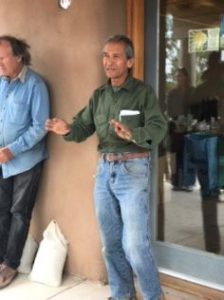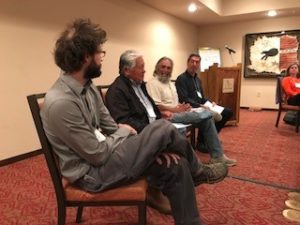
By Martha Cecilia Ovadia, Senior Program Associate, Equity and Communications
As mentioned in our recent post on solutions journalism, the Intermountain West Funder Network recently convened in Santa Fe, N.M. for its annual meeting. This years event focused on forward-looking strategies that would help funders increase the impact of their grantmaking to create more resilient, sustainable and equitable communities in the Intermountain West region.
One of the main themes of this year’s IMWFN meeting in New Mexico was learning about collaboration in investing in local communities, their food systems, and their agriculture. Henry Rael, program officer at the McCune Foundation, opened his session on regional food systems and economies in New Mexico with these questions for funders:
“How formalized or institutionalized does a behavior have to be to qualify as ‘collaboration’? Could it be holding the door open for someone as they enter the grocery store? Could it be getting together on a Saturday in November to make dozens of tamales together because it’s easier than each of us making them ourselves? Or is it MOUs among growers to organize cooperatives that aggregate and monetize their produce? Or is it spending one’s food dollars at a national grocery chain, to at a farmer’s market, or convenience store?”
According to Henry, we must define “collaboration” broadly to include all the different examples mentioned above, both formal and informal, conscious or unconscious, in-person or by proxy, by accident or on purpose. This comes as no surprise for those of us that do equity work in any philanthropic sector. We know that with a diversity of voices and peoples at the metaphorical table, better, more efficient, and equity-focused outcomes grounded in community and justice can be expected.

When reflecting on food culture itself, Henry went on to say that he viewed culture as “the relationship between people and place over time. It is something that emerges as a people choose to be in a place for generations. People figure things out. They learn about the dangers and treasures that are held by that in bed.”
As funders, this regional relationship with place must inform approaches to investing and collaborating with local communities. It is fundamental that we acknowledge that work on regional food systems, food justice, and water is place-based and people-based by its very nature. It cannot be done from a distance. It needs to be grounded. When speaking about the origins of the concept of a food system, Henry went on to say:
“In the beginning, there was a food system and it was called ‘nature.’”
Once humans got involved and began to understand the benefits of agriculture, economies became a factor. And what happened next, specifically in New Mexico, was colonization. Europeans, missionaries and conquerors forcibly disrupted the relationship local communities had with food and changed it forever. Over the next several hundred years, these different cultures mingled at the fringes, influencing each other and yielding, at times, something new and distinct.”
In New Mexico, the evolving local food system has been celebrated for its collaborative approach to working with regional communities, farmers, and ranchers. There is an effort to return not only to place, but to place-based relationships with people, nature, food and skills. Small-scale growers are at the front lines of reestablishing that oldest of relationships between their communities and the earth, taking an authentic and localized approach of local farms to local produce to local tables to local communities. This approach to regional food systems refreshingly (and not surprisingly) looks to return to the food cultures of those who came before—reflecting what we can term as “original food systems.” It is also a communal approach with a centered ethic of care for the land and its people. What is emerging is a new food culture that looks and feels more like the old food culture, a new system reaching to embody the values of the original food system.
Some practical approaches to collaboration with local farmers and ranchers shared during the IMWFN annual meeting in Santa Fe:
- Focus on funding programs that focus on the next generation of farmers and ranchers.
- Support equitable water and land use initiatives: this includes advocating for all stakeholders and collaborators to be at the table as decisions are being made, not just those with economical or judicial power. Collaboration, as we learned, is synonymous with community.
- Share the data: Shared data amongst all involved helps create better understanding and collaboration. Make sure the data has an equitable lens that captures all of the concerns of all involved in a holistic way—people, place, land, and a sustainable future.
- Be flexible. Listen to those on the ground who know the land, the people, the water, and the systems in place. Transition from top-down power to learning circles.
- Think long-term commitments to a community and place vs. short term outcomes.
Additional resources:
- The Resilience in New Mexico Agriculture Strategic Plan, a project funded in part by TFN members the Thornburg Foundation, W.K. Kellogg Foundation, McCune Charitable Foundation and the Santa Fe Community Foundation.
- Food LINC (Leveraging Investment for Network Coordination), a project that brings together multiple USDA agencies and 18 private foundations that include TFN members and IMWFN supporters the Thornburg Foundation (New Mexico) and Gates Family Foundation (Colorado). Surdna Foundation also funds Food LINC at the national level and participated as a speaker at the IMWFN gathering.
About the Author
 Martha Cecilia Ovadia is TFN’s senior program associate for equity and communications. Contact her at marci@www.fundersnetwork.org.
Martha Cecilia Ovadia is TFN’s senior program associate for equity and communications. Contact her at marci@www.fundersnetwork.org.
